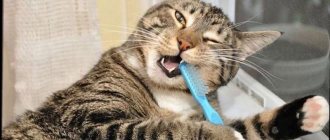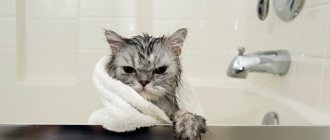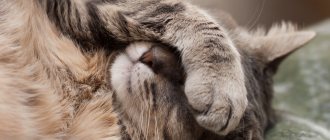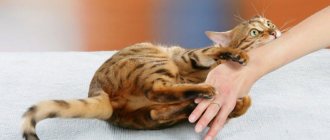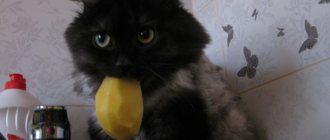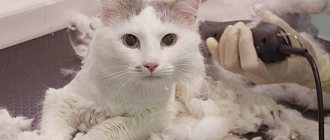Save the article:
If a person decides to have an animal in the house, then first of all it is important to find out what kind of care the animal requires. Cats calmly react to manipulations with a comb, many even like to bathe, but when the owner decides to trim the cat’s claws, that’s when problems begin. Even tiny kittens can become seriously angry if the procedure causes them the slightest disturbance. It is necessary to understand the animal’s fears of a procedure that is unnatural for its natural instincts. But there are objective reasons explaining why it is needed and what benefits it will bring to your pet.
It would be a mistake to approach the animal with a brave, quick step and immediately rush into battle - but a real battle will unfold for the right to wear long claws if you approach the matter at a swoop and without properly preparing the cat.
It’s good that you don’t need to discover America in this matter, and there are already ready-made working tips and detailed instructions to help you trim your cat’s claws correctly .
Why do you need to trim your nails?
global $ads_google; //data-ad-slot=”2475549904″ $ads_google = empty($ads_google) ? false : true; ?> if ($ads_google == false) {?>
$ads_google = true; ?> } ?>
Claws are horny skin formations that grow throughout life. Under natural conditions, claws are regularly worn down during life. An animal does not need to worry about shortening its nails, as a person does: nature itself does manicures for cats. Those animals that their owners release to frolic in the wild wear off their claws by climbing trees and running on asphalt.
Domestic cats also try to shorten their claws on the owner's walls, scratch the door frame and any wooden covering. How many times can you hear the indignation of owners about torn walls, upholstered furniture and numerous traces of cat scratches!
A scratching post allows cats to act in accordance with their instincts, but this does not help much - it’s trite, the cat can ignore the convenient device and enthusiastically continue to tear apart the corner of his favorite sofa. However, the scratching post will not have a significant effect on shortening the cat’s claws.
If you do not help the animal and do not trim the cat's claws, then long claws may grow into the pads of the paws, and the animal will suffer while walking.
Veterinarian advice
Before you buy silicone pads for your cat, you should listen to the advice of your veterinarian:
- Silicone caps should only be applied to a healthy animal that does not have fungal or infectious lesions on its paws. If there are wounds or irritation on the pads and between the toes, it is better to abandon soft claws for a while and treat the animal.
This is what healthy claws look like
- Since various microorganisms and fungi can accumulate between the cap and the pad, you should regularly inspect your cat’s claws with anti-scratch guards for infectious and fungal diseases.
- If glue gets on the skin during the procedure, the claws will grow and pull it along with them. In addition to the fact that the resulting cracks are very painful, they can become infected. Therefore, the paws need to be inspected daily, and the pads must be applied very carefully.
- The cat may have an individual intolerance or allergy to glue. If irritation, swelling, hyperemia (redness) appears on the toes and between them, you should consult a veterinarian. The caps will most likely have to be removed and the animal given appropriate treatment.
When deciding to give your beloved cat a glamorous and practical “manicure”, it is worth reading on the forums not only the reviews of veterinarians, but also the opinions of cat lovers who have already experienced anti-scratch treatments in practice.
Before the procedure, it is very important to take into account both positive and negative opinions, analyze them and make an informed decision that will not harm the animal.
And let all the fashionistas die of envy
Anti-scratch products for cats: reviews from veterinarians and animal owners are very contradictory. After all, although they solve the problem of furniture damage, they still limit the cat’s instincts.
Graceful cats are becoming the choice of true aesthetes. The trouble with these people is that it is often difficult to combine a millimeter-corrected interior with a cat. Cats perceive curtains, wallpaper, and sofas as a springboard for sharpening their claws. Even the most well-mannered beauty can involuntarily scratch not only the furniture, but also her owner, and if there are children in the house, then the issue becomes a serious one. The civilized world has long switched to anti-scratch products for cats, as the most humane way to combine the natural instincts of cats with human life.
Cat Nail Trimming Tools
Before telling you what tools are used to trim a cat’s claws, it is worth warning that they are not used under any circumstances: ordinary scissors are not suitable, however, neither is the housewife’s favorite manicure set. As an exception, sometimes only a nail file is used for polishing nails.
Specialized pet stores are not uncommon, as are veterinary pharmacies, so you can safely purchase a variety of cat care supplies there. In such places they will always advise and select convenient tools and even give advice on how to trim a cat’s claws.
What is used for cat manicure:
- a nail clipper, which must be sharp. Dull blades often hit sensitive areas and cause pain. Nail clippers are divided into sickle and guillotine clippers;
- a blood stopper or antiseptic. These medications may come in handy if you hit a sensitive part. Iodine or hydrogen peroxide work great. After cauterization, the wound is sprinkled with baby talcum powder;
- blisters - special scissors that look like manicure scissors, but are designed to resemble a cat’s claw;
- file for polishing;
- Long-haired cat breeds, such as Persians, will need a hair clipper, as fur on the paws interferes with the claw trimming process. If the cat is shy or the sound of the running machine irritates him, then the fur from the paws is cut off by hand using scissors;
- alcohol to disinfect accessories. All nail trimming tools must be sanitized before the procedure begins.
When overlays are needed
Anti-scratch caps (second name) are oblong caps made of soft plastic or silicone. They follow the shape of the claw and are “settled” on top using special medical glue. It is hypoallergenic and suitable for most cats without causing any discomfort.
Although not all owners and veterinarians support the idea of wearing such attachments, there are several reasons when it is still worth purchasing them and teaching your pet to walk in them.
- Small children. Kids love to play with cats, cuddle, pull by the tail, pinch and show love in other “non-standard” ways. Not all animals are able to tolerate bullying and react calmly to it. Some may use their claws as a defense and inadvertently injure the child's skin. In such cases, anti-scratches will be one hundred percent justified.
- Protection of household items. Not only sofa upholstery, wallpaper and door frames, but also curtains, carpets, children's toys, and clothes often suffer from tenacious cat claws. To protect interior and wardrobe items from damage (often irreversible), you will have to use overlays.
- Character traits. It happens that cats cannot be re-educated or show aggression towards their owners, guests, children, etc. They can rush at imaginary offenders, scratch themselves, break free from their hands - behave nervously and inappropriately. Or hurt other domestic animals present on their territory. The use of caps will reduce the risk of injury and slightly pacify the cat's temper.
- Household safety. Here we are talking about possible harm to health. The claws contain microbes, and if there are deep scratches, they can enter the wound, causing inflammation. In the worst case, blood poisoning. People who have weak immunity, poor blood clotting, or a predisposition to various allergic reactions should beware of damage.
How to prepare your cat for the procedure
The owner must know the character of his cat and be able to adapt any procedures to it. This is especially true for nervous or aggressive animals - they may react ambiguously. It’s good if more than one person trims a cat’s claws at home: in such a matter, an assistant will not be superfluous.
A cat that is quite nervous and struggles vigorously should not be forced. In the process of fighting, trimming the claws can injure the paws. You should wait until your cat is in a calm mood before attempting to trim her nails again.
global $ads_google; //data-ad-slot=”2475549904″ $ads_google = empty($ads_google) ? false : true; ?> if ($ads_google == false) {?>
$ads_google = true; ?> } ?>
They begin to accustom the animal to any manipulations at the age of a kitten. In any case, the pussy should not be afraid of having its paws touched. Prepare all the tools and wait until your pet is calm.
First, the cat is stroked on its paws and its favorite places. Be sure to stroke every paw. If your pet wants to leave, do not delay her - she must be sure that nothing will be done against her will, and she will calm down.
If your furry pet lets you pet its paws, you need to praise it and treat it with treats. She will get used to such manipulations and will be happy to allow you to touch her limbs.
The cat's paw is placed on the palm and treated with a special treat, which will be given whenever they plan to trim their claws. The paws are massaged one by one with the fingers and at the same time the claws are examined. An animal that trusts its owner will allow pressure on the pads to release its claws.
It is better to entrust the procedure to professionals
In a professional veterinary center, this operation will be performed quickly and safely for the animal. The experience of the master will allow you not to injure either the paws or the psyche of the animal. The procedure is inexpensive and not difficult for a professional, so it is better to get a cat “manicure” done in a specialized salon.
How does the procedure work?
First of all, the animal must calm down and get used to the master a little. The following is done:
- The animal is carefully held in the hands;
- Light pressure on the paw pad exposes the claw;
- A special tool is used to trim the horny part with the necessary distance from the blood vessel and nerve;
- If necessary, use a special file for grinding;
- The paw is disinfected.
The owner is nearby at this time, you can even perform the operation in such a way that the cat is in his arms - this way the animal will tolerate the procedure more calmly. In general, nail trimming takes no more than 5 minutes. If a cat has certain pathologies, injuries or diseases of the pads or the claws themselves, additional treatment may be necessary, for example, with various medications.
Tools
To trim cat claws, a special nail clipper is used, which allows you to remove the horny part at the required angle without touching important parts. A sanding file can be used. Tools of different sizes are used, depending on the age and size of the animal. All instruments are required to be sterilized before and after each operation. In his work, the master uses disinfectants that are safe for the health of the animal. The procedure is carried out with maximum care and attention to the cat.
Basic rules for trimming nails
To trim a cat’s claws without any problems, you need to follow the same scenario, which includes preparing the animal and the procedure itself.
You can entrust a cat's manicure to a specialist, but it is quite possible to trim a cat's claws at home on your own.
- The claws contain a number of nerve endings and blood vessels that form the pulp. It should not be injured, as it immediately begins to bleed and the animal becomes very painful. No more than 2 mm of the stratum corneum is cut off.
- The procedure is scheduled for daytime so that the claws are clearly visible.
- After preparing the animal, they take it on their lap and talk affectionately. The cat hears the owner's voice and is distracted by it.
- Lightly press on the pad of the paw: the claws should appear.
- Using forceps, only the upper part of the stratum corneum is cut off.
- Repeat the same with the hind legs.
- It is better to sand the ends of the cuts with a file and be sure to remember to treat each area with an antiseptic.
- After the manicure, the cat is praised and again treated to treats.
To properly trim a cat’s claws , take into account the condition of the animal: do not touch the animal on an empty stomach or during active pastime. You must be confident in the health of your pet. But when the cat is getting ready for bed, has eaten a hearty meal and looks happy - it’s time.
If it so happens that the family favorite has damaged its claw, but its condition is not recommended for haircuts, leave it alone for a while. Manicure must be done strictly according to the rules!
What to do if the animal is not given
Cats have different temperaments, some are calm and calm, others are aggressive and nervous. The latter are unlikely to allow their nails to be trimmed in peace. Most likely, the animal will scratch, bite, and break out.
You cannot force a cat to trim its claws; you need to gradually accustom it to the procedure.
If the cat doesn't give in, you can't show force. This can only injure your paws. It is advisable to perform the procedure by two people: one holds, the other trims the claws. You can also swaddle your pet or wrap it in a blanket.
If he is very nervous, it is better to refuse the event and do it when the animal is more pliable and balanced.
How often to trim a cat's claws
Cat manicures are done as needed, namely as soon as the length of the stratum corneum grows. Usually this takes three weeks. If you do this less often, the animal will wean itself off the procedure.
Always trim before exhibition.
It is enough to check the condition of her claws once a week, and an attentive owner will understand when it is time to trim the cat’s claws.
If something goes wrong, the animal may require veterinary attention. Remember that the main conditions for cutting are the cleanliness of the tools and the animal’s trust in you.
Declaw surgery
The last resort in the fight against cat hooliganism is complete declawing. In society you can find completely opposite opinions about such medical intervention.
Photo: complete declawing is a very dangerous operation
Some believe that the operation saves the animal from constant claw jams and subsequent suffering, and the person from unpleasant scratches and damaged furniture.
However, many, including animal protection organizations, are confident that such a dangerous operation will only bring suffering to the pet, since it deprives it of a natural universal tool for climbing, hygiene and self-defense, and can lead to blood poisoning, paw deformation and death.
It is also worth considering that this type of surgery involves removing the top of the cat's toes.
If you didn’t succeed in taming the animal to use a scratching post, and partial cutting of the claws does not solve the problem, but you still decide to completely remove the source of trouble, you should contact a veterinary clinic.
Under no circumstances attempt to perform the operation yourself! One wrong move can lead to severe hemorrhage and even death of the animal.
The operation is performed under anesthesia using conventional instruments or a laser. The cat may be hospitalized for one to two days and kept in the clinic.
Remember that care after declawing surgery is quite complex:
- for the first week, you need to replace the usual tray filler with paper so that the granules do not stick to the incision sites;
- limit the animal from unnecessary physical activity, especially jumping;
- make sure that the seams do not come apart. If you notice bleeding that doesn't stop, call the clinic immediately.
Photo: the owner must show the cat where to sharpen its claws
Caring for a cat’s claws is a very important procedure that simply needs to be done regularly. The best solution would be to purchase a scratching post so that your pet can do its own manicure.
Caring for a pregnant cat is described in more detail in the article: Caring for a pregnant cat.
For how much you can buy a Bengal cat in Yekaterinburg, see on the page.
Find out what to feed your Bengal cat from this information.
Contact the professionals
Trimming a cat's claws is not a mandatory procedure, but in some cases it is necessary. In addition to forced operations (claws injure the pads), animal owners turn to experts simply for cosmetic purposes, to make the claws less sharp and rid household items of holes and scratches. It should be remembered that cutting claws is not a panacea and the animal will still scratch, despite the fact that the claws themselves grow back quite quickly. Therefore, in addition to turning to the experts for such a service, you should definitely have several special scratching posts at home so that the cat can satisfy its instinct.
Do I need to trim my cat's claws?
Should you trim your cat's claws or not? On the Internet, supporters and opponents of the procedure break their spears, but everyone decides for themselves and I think a lot depends not even on how sorry you are for your great-grandmother’s antique chest of drawers or wallpaper. And it depends on how close a friendly relationship you have established with your animal and how many clawed animals live in the same apartment.
Our first acquaintance with scissors for trimming claws took place about a month after the Chupacabra arrived at its new home. The furniture was somehow indifferent; the cat liked wires more. But more than wires, he loved to settle down in my hair on the pillow and begin to “claw” his mistress’s head with special tenderness. When it became clear that scalping could not be avoided, we went to a veterinary pharmacy and bought special nail clippers - a guillotine trimmer.
Mmyaaaaaaaaaaaaaaaaaaaaaaaaaaaaaaaaaaaaaaaaaaaaaaaaaaaaaaaaaaaaaaaaaaaaaaaaaaaaaaaaaaaaaaaaaaaaking on on the owner's lap, belly up. This loud, mournful “Mryaayuu” accompanied the entire grooming procedure, while the cat was coaxed and kissed on each paw, so that no one else was hurt, although one of the paws was catastrophically close to the owner’s neck.
With age, the Chupacabra became more relaxed about the procedure for trimming its claws, and I began to trim its claws correctly - after all, you can’t just cut off the tips of a cat’s claws, you need to do it at the right angle and without going beyond the norm.
At the same time, we have a scratching post in the house. But a cat doesn’t always only need it for nail hygiene, and it’s the haircut that saves us from unnecessary injuries - after all, we also have a second cat with special needs.
Although, even with their claws trimmed, my cats pulled up two duvet covers into rags - that’s just their hobby!
A cat needs claws when it lives in the wild. A domestic cat climbs trees less and is generally less mobile, so its claws do not wear down and often grow longer than necessary. And then the cat turns into a Cheburashka - constantly clinging to everything with too long claws. Which can lead to injury to the animal, which no one would want.
It is important to understand that trimming a cat’s claws does not hurt. If you do it correctly and carefully, without touching the nerve endings. And she may hiss and be indignant out of fear of a new, unfamiliar object in your hands.
The need for this procedure is determined by the owner. All domestic cats can have their nails trimmed; it will not harm them in any way. Unless it's a cat that lives outside, it needs its claws for protection. There is an opinion that a cat that is accustomed to clinging with its claws when jumping may be injured if its claws are trimmed. This is possible in very rare cases, if the cat is used to climbing on curtains, for example. But this does not apply to animals that were taught to trim their nails as children.
It is necessary to trim the nails of older animals if they have a problem with ingrown claws, they do not file down their claws properly and they grow too long and can pierce the pads of their paws. This causes pain and discomfort for the cat and can also lead to suppuration.
What tools can you use to trim a cat's claws?
The choice of tool for trimming a cat’s claws depends on the capabilities and skillful hands of its owner. Some people use regular nail scissors or nail clippers; we bought special scissors with a hole for claws - a guillotine trimmer. There is essentially no difference, it’s just that it’s probably more convenient to cut with special scissors.
There is also an electric cat claw trimmer, somewhat reminiscent of a mechanism for a hardware manicure. I don’t know how your cat will react to this - mine don’t like buzzing objects and, I’m afraid, it would be completely impossible to hold it in your hands while trimming its claws with such a device.
Some websites now sell special restraining overalls for particularly violent ones. If your cat absolutely refuses to part with the scratches peacefully, perhaps such a device can make your life easier


